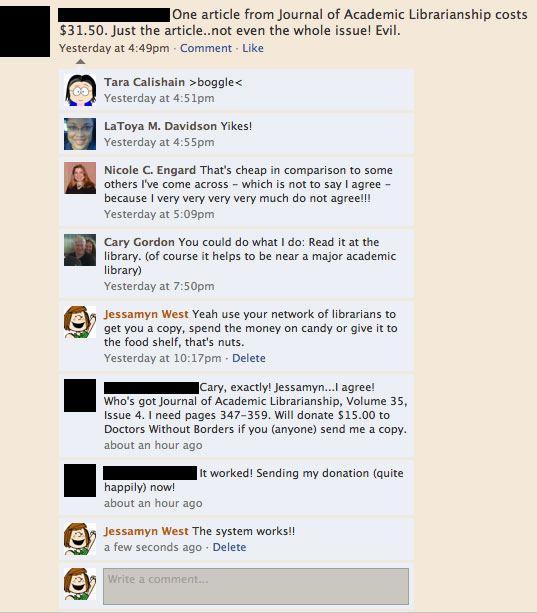I upgraded WordPress this week. Please let me know if anything is wonky.
This is an exchange from facebook with names changed to protect the innocent. It highlights something I find happening to me in the library world all the time — having to balance solving the problem with following the rules. The person posting the update needed an article. The rules said they had to pay $31.50 for an article. This didn’t pass the sanity check [“$30 for one article from a journal, that’s crazy!”] and the librarian was grousing. They’re also grousing to a huge network of librarians, many of whom had free [or, paid for by their institution] access to the same content. I saw Nicole speak in Florida this past week and one of the quotes she repeats again and again is “With enough eyeballs, all bugs are shallow” meaning that a particular coding problem that might vex one or two programmers is unlikely to vex, say, a thousand programmers.
My Jessamyn corollary to this is “With enough libraries, all content is free.” That is to say… if the world was one big library and we all had interlibrary loan at that library, we could lend anything to anyone. The funding structures of libraries currently mean that in many cases we’re duplicating [and paying for] content that we could be sharing. This is at the heart of a lot of the copyright battles of today and, to my mind, what’s really behind the EBSCO/Gale/vendors. Time Magazine is losing money and not having a good plan for keeping their income level up, decides to offer exclusive contracts to vendors and allows them to bid. EBSCO wins, Gale loses. Any library not using EBSCO loses. Patrons lose and don’t even know they’ve lost.
When I was blogging for BoingBoing I often came across content that I didn’t have access to. I was also confronted with, in many cases, unreasonable fees requested [$9.95 for 100 words, really?]. Me being me, I could always find a librarian with access to, say the Times Online archive, or old articles in JSTOR. But I also felt it was cheating. But I was also annoyed that being resourceful is also somehow cheating. And I knew that many of my patrons with fewer resources would just pony up. Where do we draw the line between enforcing other people’s rules and solving problems with our patrons? Now that we’re getting more and more networked, this whole idea of local content works for some things [historical photos, town history] and not for others [journal articles that are held in thousands of libraries worldwide]. Do we have a plan for moving forward?
